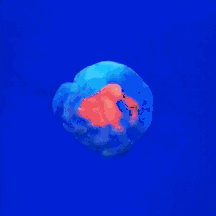28 May 2020
Meet the Ganimals
Posted by Shane Hanlon
By Ziv Epstein, Micah Epstein, Matt Groh, Josh Hirsch, Oceane Boulais

GIFs of Ganimal creation
As computer scientists with a heart for education and curiosity of the social sciences, we began exploring the blurry lines of ‘discovery’ and ‘stewardship’ in the digital space of artificial intelligence.
The mechanism that drives the bevy of conservation-forward philanthropy can be credited to the human tendency to gravitate towards the disproportional support of charismatic megafauna relative to diversity of organisms in the natural physical world. Inspired by the unseen and underappreciated diversity in the ocean, we have built a platform to test our hypothesis: do we show an inclination towards “artificial” species that contain familiar characteristics of the megafauna that dominate our physical world? Hidden in the weights of a generative adversarial deep neural network (or GAN) is a new world, teeming with new species never seen before. People can discover new “ganimals” and help feed the ones already discovered. The act of choosing which ganimal to feed guides the evolution of the digital ecosystem through recommendation systems and evolutionary algorithms. Therefore, these feeding decisions measure how people use social and aesthetic information in their inclinations.

GIFs of Ganimal creation
No one knows what the ecosystem that results from this collective discovery will look like. Will we find a couple “charismatic megafauna” that dominate the other ganimals? Or will the ecosystem help people see beauty in more holistic, unexpected ways? These questions are important to natural world scientists who seek answers to why certain research agendas are given philanthropic preference and media visibility over others. AI offers us a toy artificial laboratory, almost entirely untethered to the social and cultural priors people carry about the natural world, to investigate this hypothesis.
Right now, stuck in physical isolation, is a powerful time to reflect on how our psychology impacts both digital and natural ecosystems. Where we shine our attentional spotlight is not arbitrary, but rather is dictated by social, cultural and informational forces. Ultimately, the nucleus of our attention is an indicator of our intention. By playing the role of explorer and steward of the ganimals, perhaps we can heighten our awareness of the work that remains to be done, when life on earth returns to “normal.”
–The authors created Meet the Gamianls as part of the MIT Media Lab.


 The Plainspoken Scientist is the science communication blog of AGU’s Sharing Science program. With this blog, we wish to showcase creative and effective science communication via multiple mediums and modes.
The Plainspoken Scientist is the science communication blog of AGU’s Sharing Science program. With this blog, we wish to showcase creative and effective science communication via multiple mediums and modes.